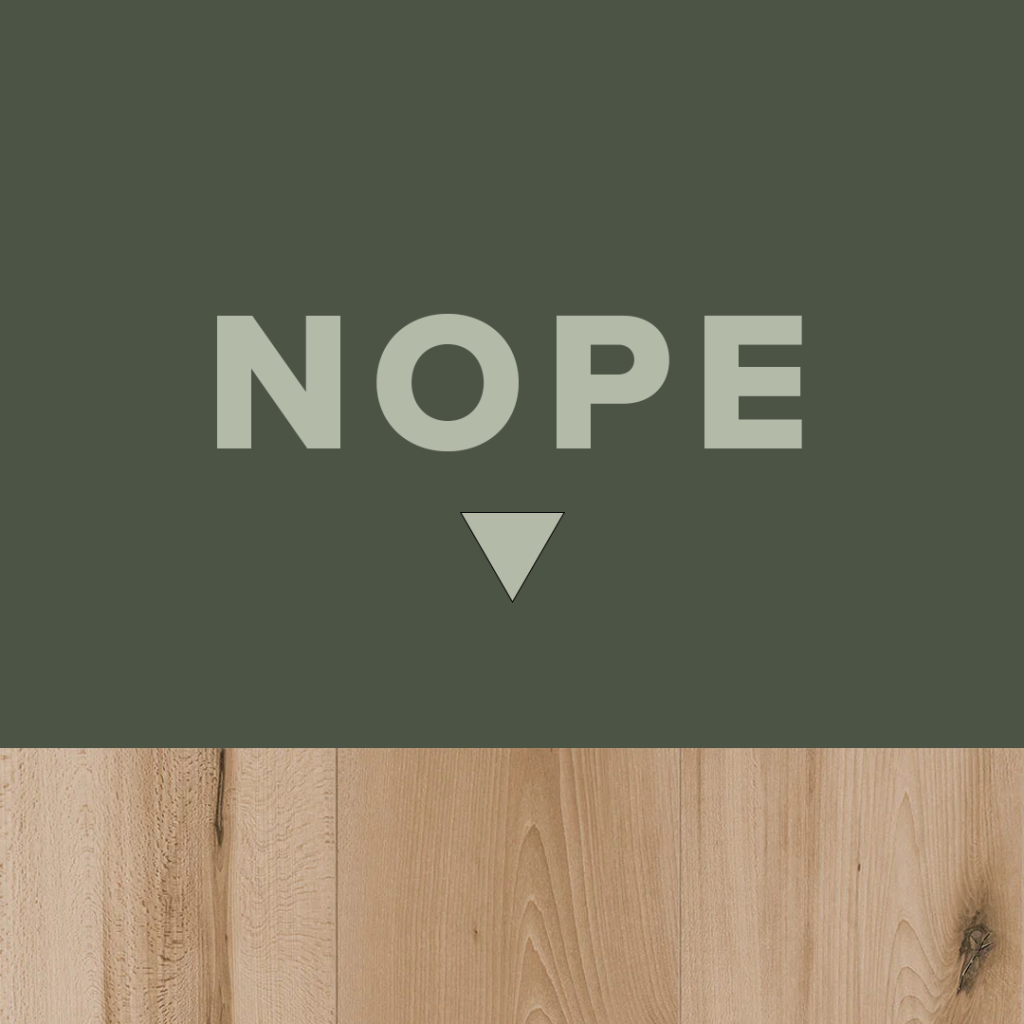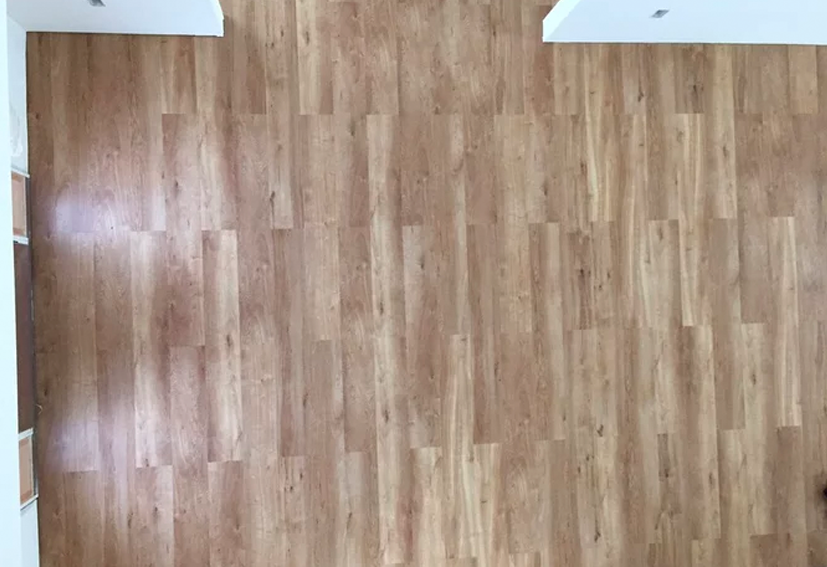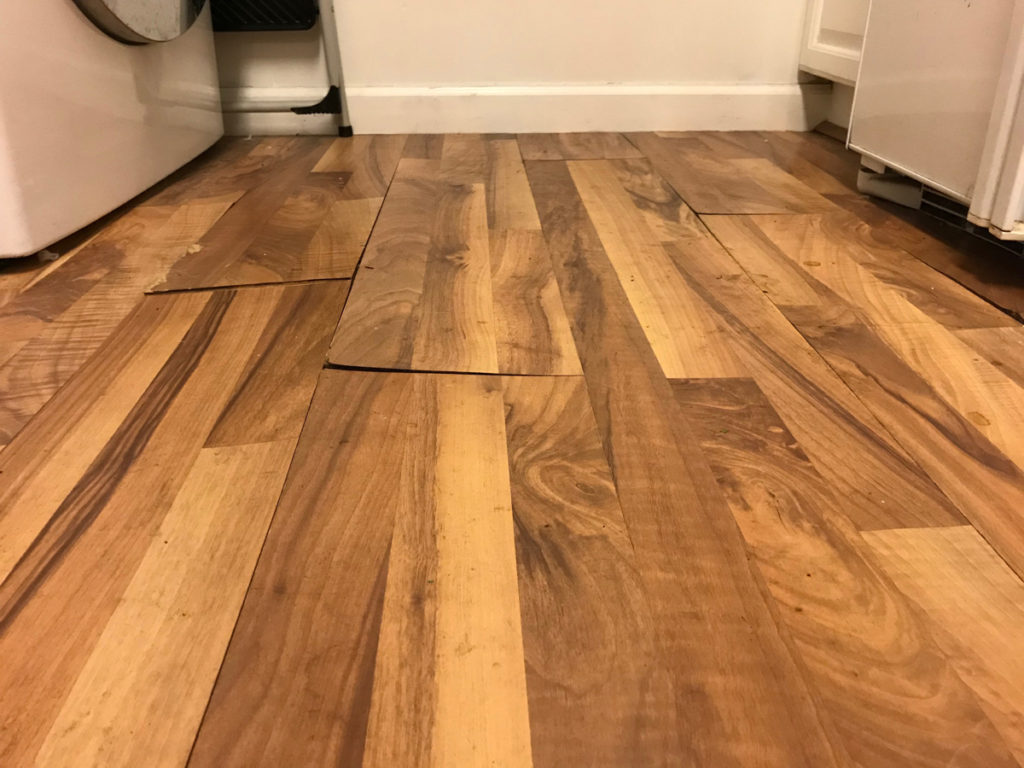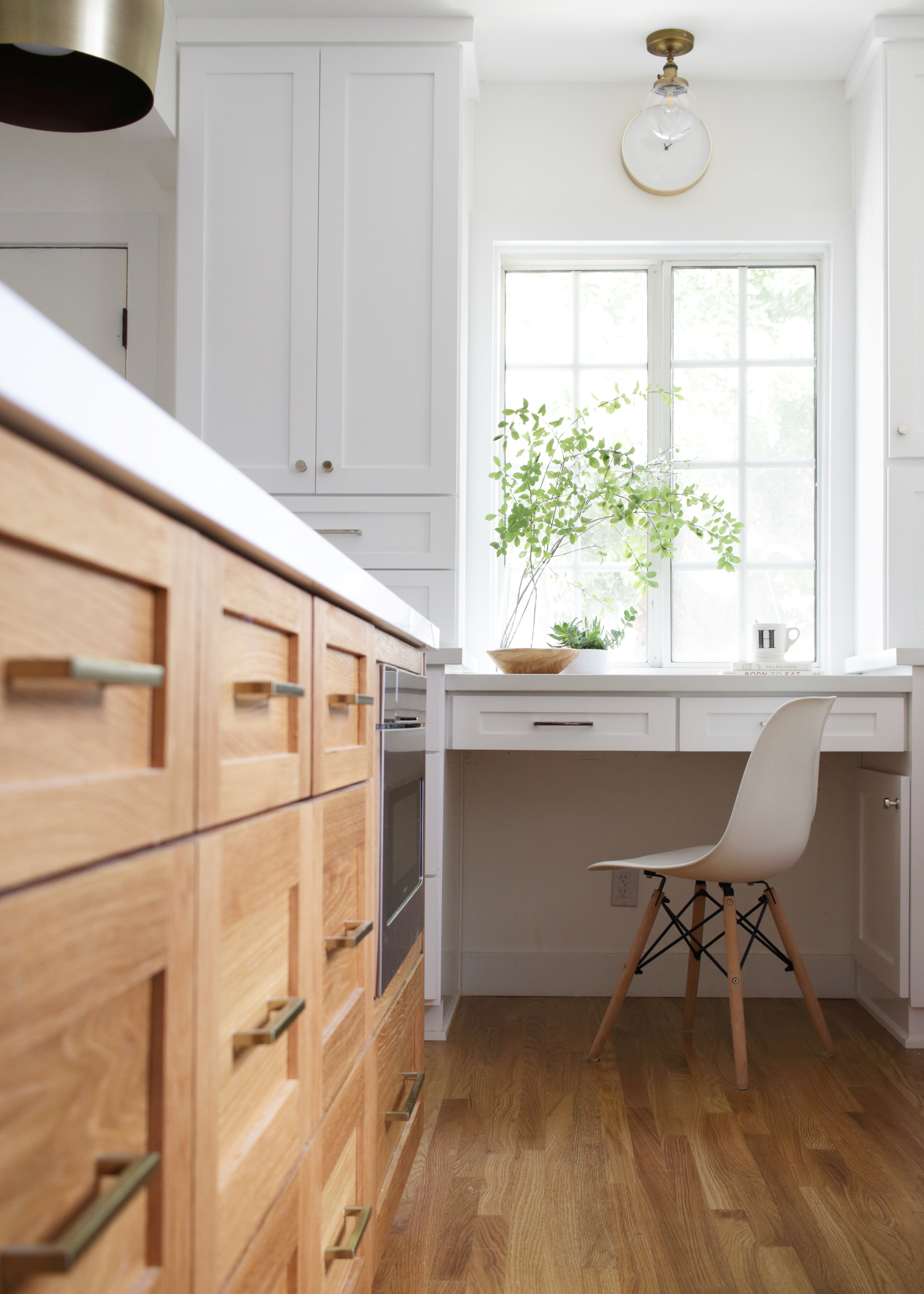Why I Hate Luxury Vinyl Flooring (LVT / LVP)

Many people think that because my blog is called “Bay on a Budget,” that my philosophy is “the cheaper the better.” This couldn’t be further from the truth. This is where we come to luxury vinyl flooring and why I hate it so much.

Luxury Vinyl flooring looks like printed plastic to me, and that is essentially what it is. LVF has 4 – 6 layers: An underlayment (usually made from cork), a rigid core, a printed layer and a wear layer. The wear layer is what protects the printed layer and can vary in thickness depending on the brand. Once you’ve worn through the top wear layer and expose the printed layer underneath, the flooring has to be replaced. And unlike real wood, LVF eventually has to repeat its printed pattern; so when you’re looking at a large swath of flooring, you can see duplicates of the same board. If you have a careless installer, they may even place two identical boards side by side.
Waterproof?

Luxury Vinyl Flooring is not as waterproof as people think it is. While LVF itself is water resistant, it does not protect your subfloor from moisture. In fact, water can still leak through the cracks and damage your subfloor or grow mold. And because it’s easier for water to go down rather than up, it’s much harder for water to evaporate once it gets under the LVF. In fact, a lot of the clients that hire me have water damaged kitchens or bathrooms that went unnoticed because they had wooden subfloors covered with laminate or LVF.
Also, once an LVF floorboard is scratched or damaged, you cannot refinish it like hardwood. You have to replace it. And if you don’t have enough replacement boards and that particular style is discontinued from the manufacturer, then you’re in a pickle.
Health Concerns
LVF also off-gasses for the remainder of its lifespan. It will continue leeching VOCs especially the parts that are exposed to sunlight. And unlike hardwood, which gets richer in color over time with UV rays, LVF actually fades with constant UV exposure.

As a society we’ve become hopelessly dependent on plastic and studies have shown that the phthalates and BPAs in the many plastic products we use are having catastrophic effects on our hormonal and reproductive health. I work a lot with young families with pregnant mothers and/or small children. Endocrine disrupting chemicals are especially consequential for developing fetuses or young children crawling on the floor. When a huge swath of your home is covered in a product that off-gasses toxic chemicals, the damage it can do overtime is incalculable.
Environmentally Unsustainable.
Vinyl planks are almost impossible to recycle. At the end of their life they often end up in a landfill where they breakdown into microplastics.
Not all that affordable
Sure, you can find a very realistic looking LVF that has a lower VOC count made up of recycled materials, but at that point, you often end up paying $9- $10 per sq ft at which point you have entered the hardwood price bracket.
I think it’s a toxic, ecologically unsustainable product. It always looks artificial to me and I rarely recommend it to any of my clients. I have managed to steer almost every client away from it, and they are always so happy that I did in the end. I actually had one client who opted for LVF and now they say the floor feels soft and spongy. Needless to say, they wish they did engineered or hardwood floors.
This is not to say that there are not applications in which LVF may be useful. And not all vinyl planks are created equal. I will sometimes tolerate LVF in commercial spaces where the use of hardwood might not be practical and the long term VOC exposures are minimal. But at that point, I’d rather just use tile.
For more information, check out: Green Building Supply
What should I get?
I usually recommend hardwood or engineered hardwood to my residential clients. It is sustainable, significantly less toxic and just looks more beautiful.

41 Replies to “Why I Hate Luxury Vinyl Flooring (LVT / LVP)”
I’m so glad to read this article and I couldn’t agree more. I’m a real estate agent here in Florida and most recent home remodels I’ve seen; with the exception of just a few now, are using luxury vinyl flooring. It’s plastic and you might as well call it “pergo” flooring. What’s disheartening is that I’m seeing it in homes that are supposed to be considered luxury and they are cheapening out the floors. Here in South FL we should stick with natural marble tile or if you happen to have terrazzo, have them diamond grinded/polished. Let’s please put an end to the plastic floor trend and return to natural elements of floors that will and should last a lifetime.
Finally! Somebody in the industry saying what I’ve thought since it arrived in the scene in every renovated home I’ve looked at! Words cannot describe my dislike for this product. It’s ugly. It makes every home feel like a doctors office. It’s cold. It looks cheap & so fake. If I see one more house in my search that has grey LVT throughout, with grey walls and grey cabinets, I think I’ll scream. It’s a travesty when you see a beautiful older home and they’ve thrown that in top of the hardwood floors.
I have hardwood & carpet in bedrooms (needs removing) and was looking for some honesty on LVP. The toxicity is very important (asthma) so thank you for mentioning it.
Thank you for your honesty. We’re house-shopping and see so many of these ugly grey LVP floors. They’re an instant ‘no’.
Hideous. And they don’t match anything except aqua, so we’re out of luck if that’s not our style (it’s not.) They say “it was a cheaply done flip” to which I say “no thanks.”
As someone with asthma who cares about indoor air quality, I appreciate your voicing health concerns about vinyl flooring. I like to refer to https://www.mychemicalfreehouse.net/ for info about different products.
I’ve been appraising houses for over 30 years. and I fully agree with the author of this article. Besides the downfalls of this product; what ever happened to imagination. Over 99% of the new construction in recent years use it no matter what the prices is. I see million $+ houses constantly that don’t even require a look; they are all the same. Totally disgusted.
Ever talk to restoration people?
Do you remember the popularity and often required use of woodruff roofing or LP siding. Builders should know better. The buyers have been conditioned to buy junk.
Is there a type of flooring that is waterproof?
Many types of flooring are considered waterproof like stone, ceramic/porcelain tile. The issue comes down to whether your subfloor is wood or concrete. Even the best waterproof flooring can’t stop water from seeping into the subfloor in the case of prolonged exposure to water/flooding. The only thing that could do that would be a large seamless sheet of linoleum or vinyl flooring. But most people don’t like that look.
Curious what type of floor would be advisable in a basement over concrete – needs to be waterproof – so natural wood is out – and not too live sounding like tile would be due to our required use by a musician. Is linoleum kinder to the indoor air than vinyl?
I actually think linoleum is making a comeback. It is definitely better for your indoor air as it is made from linseed oil and just as durable as vinyl. If you’re making the basement into a studio, I’d recommend exploring carpet tiles too.
What floors do you recommend ? If not lvp. And adforabale at the same rime
It really depends on the room. If it’s a bathroom, I’ll usually go for a ceramic/porcelain tile. If it’s more high-end, I may use a natural stone like marble or travertine. If it’s a living room or bedroom, I’ll generally go with an engineered or solid hardwood. You’d be surprised how affordable some engineered hardwoods are.
How about tile? Would you recommend it or no?
I love tile! Porcelain, ceramic, or stone are all great in my book.
Well would traditional square tiles be better like in bathrooms or are the wood look ceramic or porcelain tiles considered a better look, as I have moisture issue and dont want all those voc chemicals either
I personally use stone or ceramic/porcelain tiles in my bathroom designs. I think the wood look tiles are ok, but sometimes they can look a little fake. I generally avoid LVP in a bathroom. Not just for the VOCs, but because it looks cheap to me.
Thank you for saying what I think about lvp.
You have no idea how much this has helped me.
But what would you recommend for high-traffic/heavy wear and tear in rental units?
Hardwood is out of the budget and just not durable enough.
Rental units are a different story. I can see LVP making sense in a rental where you need something that can take a beating that won’t break your heart. Like I mentioned, I will sometimes concede to LVP in commercial spaces.
I couldn’t agree more. We’re getting ready to build and have toured many $1M+ homes with LVP. I laugh and think “luxury” it is not. This is cheaper than tile, hardwood or stone and does not merit the word luxury. I remember having vinyl flooring in earlier homes and it served its purpose. People it’s OK to just call it what it is vinyl floor planks that are imitating real hardwoods. Do not act like they are on par with each other because I can refinish true hardwood in the future. The only future for LVP is the trash bin,
Omg yes, just because the word luxury is in the acronym doesn’t make it so!
Thank you for speaking out against so-called LVT. First and foremost, it is being installed in vintage homes over exquisite vintage hardwood as well as in new construction. I had LVT ‘click’ together tiles installed over luan in an older home. I watched the very conscientious carpenter ‘click’ each piece. About two years later the joints began to separate. Then, we had a leak in the island beneath the dishwasher and double sink. I asked my daughter what she was dropping on the floor? Bottom line, the brown substance seeping up through the LVT joints was actually coming from the subfloor under the island. It will be a costly expenditure to have the subfloor removed and new flooring installed. I had transition strips removed from four door openings to permit my late husband to navigate his wheelchair freely across the LVT. To further complicate the matter, Shaw industries sold and the retailer from whom I bought materials went out of business. Even if I wanted to replace the LVT in the kitchen, I have it in my Laundry Room and a very large Family Room. Give me aged natural hardwood any day.
O gosh, Helen, that sounds like a nightmare!
I have 3 large dogs, and natural hardwood floors. The topcoat of poly gets completely ruined from high traffic, it then peels and subsequently the wood gets scratched by their claws. At least that’s what I guess is happening, not an expert. I want to update our house and flooring is a huge part of this process, I’m so worried about anything I put in becoming scratched with pets. Is there a type of flooring that can withstand hard use from pets, kids, furniture, dropping things? Our current floor split from wood into carpet in the living room and it seems like it’d be a monster to find planks that would fit to our old flooring to replace the carpet. Wondering if we should just start fresh with something new but having such a hard time choosing the best product. I’ve read a lot of reviews saying the engineered hardwoods scratch terribly.
Sorry for the late reply. For people with pets, it can be a tough decision. If you were my client, I’d probably still advise some sort of engineered hardwood with a more durable topcoat. But I totally get it when people have pets and don’t want the hassle of having to refinish their wood floors every couple of years.
What would you recommend for a basement in the northeast with cement – no subflooring? Recently had water and had to remove wall to wall. Never had a problem before. Large area.
I think if you have a basement that is subject to constant moisture, LVP is not a terrible idea. But if it were me, I’d probably just put down a ceramic or porcelain tile. Or leave it as concrete and skim coat it so it’s perfectly smooth.
I am SO glad I read this article. I need new bathroom and kitchen flooring, and I’ve decided to go with ceramic tile after reading this. Thanks for helping me make up my mind!
Yes!
Thank you for this! We JUST had some installed in our home about two months ago (today is Saturday, December 2, 2023) I absolutely HATE it already! So glad we are getting ready to put our home on the market, the thought of having to live with this junk for a long period of time would be really depressing. There are several reasons why I already hate this stuff. I don’t know if it’s the color we chose (too light?) – it shows SO MUCH dirt! Not sure if the material is cheap and/or the installation wasn’t done well or a combination but already pieces have shifted so there are gaps, there are chips in a couple of places and a CRACK in one spot where it appears that the subfloor should have been sanded down first?! (or something!) SO disappointed. And of course we paid a lot of money for this! Prior to this flooring material we had vinyl (the rolled kind?) in the baths, kitchen, dining, laundry & one hallway and carpet in the bedrooms and one other hallway. (I hate carpet also, allergies etc) This was all builder grade stuff that we picked from the company that built our home years ago. While the vinyl may not have been fancy it was SO practical! It seemed very durable and the BEST feature – it did not show every little bit of dirt, hair etc!!! Thank you again for this article, I also really appreciate all of the people that commented. Learn something new all the time, sometimes the hard, expensive way!
I feel so bad for a lot of innocent homeowners who get LVP thinking it’s this miracle product only to find that it looks really unnatural when it finally goes in. There are so many nuances in real wood that cannot be imitated by LVP no matter how good the product. And yes, it’s such an expensive lesson!
I live in a 1862 house and the wood floors creak. I want to take up the old linoleum floor in upstairs bathroom and put new flooring . But my husband is worried porcelain will crack even if there’s a new subfloor put in due to the movement in our old floors. Would Lvp be better in my case?
So I don’t think LVP is necessarily a bad choice in your situation, but if it were me, I would use a smaller porcelain or stone hex tile. You could even do penny tile. I feel like it would fit better with an older home too. If you’re worried about too much grout getting dirty, you could use a gray grout.
Thanks for this article! Couldn’t agree more, for all the reasons you list. I just don’t understand why anyone would put down plastic instead of real wood on a floor. It’s not all that economical and bad for the environment on all counts. And it looks cheap!!
We live within 5 miles of a rock quarry. There are blasts daily that we can feel. Believe it or not, homes are all around this quarry and don’t get any house damage from them. However, Our home is built on a slab without a crawl space. And because of this, we feel the blasts a bit more and our tile in the bathroom has cracked over time. Also worth mentioning, the builders did not use the material underneath the tiles that is supposed to prevent cracking (or so i am told). I was ready to hit purchase on lvt but our home is high end and it’s a MASSIVE bathroom. Any advise would be appreciated. The rest of our home has beautiful hardwood throughout. I’d like to trust that, with the right materials, and a professional installation…ceramic or porcelain tile wouldn’t crack?
Oh, how I wish I’d read this 3 weeks ago😢. I would give anything to be able to change out this very expensive mistake. As the installer put in the last board, he told me that I should not mop my floor (kitchen). I almost choked. He said the water and dirt would show up in the cracks😭😭😭😭
O man, so sorry Becky! How else are you supposed to clean it??
As an architect and designer in the industry I can say I disagree with this article. LVT is highly dependent on the fabrication, thickness, manufacturer, warranty, etc. and even more dependent on the quality of installation.
We specify LVT all the time in commercial projects and they hold up and look fantastic.
Like I mentioned, not all LVT is created equal and I do sometimes use LVT in commercial spaces if it makes sense. Still think it looks bad most of the time. It’s like the uncanny valley but for hardwood. And definitely contributing to the world’s plastic problem no matter how it’s manufactured. Most of this stuff will be thrown out in 20 years, especially the cheap stuff people are putting into apartment complexes and flip homes.
I work for a church that has vinyl plank in a dining hall. When liquids are spilled, and I’m not there, they are not cleaned up. Therefore I have staining. The flor buckles every couple months and I have to heat it a put weight on It. Before I got there, it was being wet mopped every day and now it’s wavy. I have done floors for decades and am very good at it. These floors can’t be cleaned, they recommend dry mopping, and you can’t buff them like a tile floor, you cant use regular cleaners on it. And, the stuff they sell to use on them costs $ 100.00 per gallon. They are nothing but trouble. Especially where spills occur. Do not install these floors. Not worth the headache.